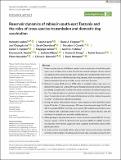| dc.description.abstract | Understanding the role of different species in the transmission of multi-host pathogens, such as rabies virus, is vital for effective control strategies. Across most of sub-Saharan Africa domestic dogs Canis familiaris are considered the reservoir for rabies, but the role of wildlife has been long debated. Here we explore the multi-host transmission dynamics of rabies across south-east Tanzania.
Between January 2011 and July 2019, data on probable rabies cases were collected in the regions of Lindi and Mtwara. Hospital records of animal-bite patients presenting to healthcare facilities were used as sentinels for animal contact tracing. The timing, location and species of probable rabid animals were used to reconstruct transmission trees to infer who infected whom and the relative frequencies of within- and between-species transmission.
During the study, 688 probable human rabies exposures were identified, resulting in 47 deaths. Of these exposures, 389 were from domestic dogs (56.5%) and 262 from jackals (38.1%). Over the same period, 549 probable animal rabies cases were traced: 303 in domestic dogs (55.2%) and 221 in jackals (40.3%), with the remainder in domestic cats and other wildlife species.
Although dog-to-dog transmission was most commonly inferred (40.5% of transmission events), a third of inferred events involved wildlife-to-wildlife transmission (32.6%), and evidence suggested some sustained transmission chains within jackal populations.
A steady decline in probable rabies cases in both humans and animals coincided with the implementation of widespread domestic dog vaccination during the first 6 years of the study. Following the lapse of this program, dog rabies cases began to increase in one of the northernmost districts.
Synthesis and applications. In south-east Tanzania, despite a relatively high incidence of rabies in wildlife and evidence of wildlife-to-wildlife transmission, domestic dogs remain essential to the reservoir of infection. Continued dog vaccination alongside improved surveillance would allow a fuller understanding of the role of wildlife in maintaining transmission in this area. Nonetheless, dog vaccination clearly suppressed rabies in both domestic dog and wildlife populations, reducing both public health and conservation risks and, if sustained, has potential to eliminate rabies from this region. | en_US |

